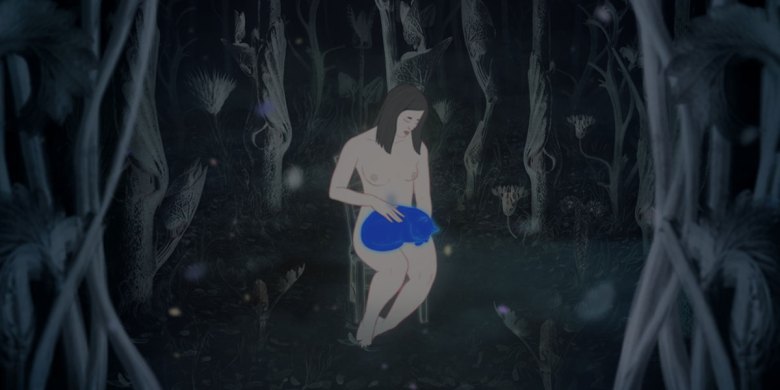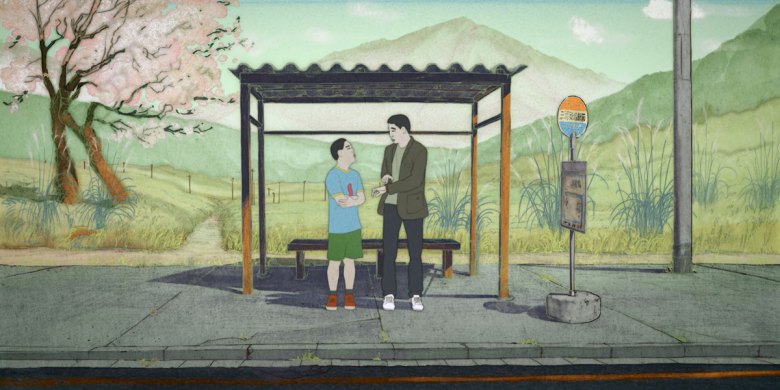After inspiring two of the most stunning features in recent years with “Burning” and “Drive My Car,” it should come as no surprise that the work of author Haruki Murakami is ripe for adaptation. His short stories are truly special, texts that are as dense as they are accessible, and filmmaker Pierre Földes knows this well. Földes’s first feature, “Blind Willow, Sleeping Woman,” takes its title from a Murakami collection and anthologizes a number of the author’s short stories — “Super Frog Saves Tokyo,” “Birthday Girl,” “Dabchick,” “The Wind-Up Bird & Tuesday’s Women,” “Blind Willow Sleeping Woman,” and “UFO in Kushiro” — to create an intimate and playful study of characters looking for meaning in their lives.
Weaving together these stories — and their wide-ranging subject matter that includes break-ups, office-job monotony, strange wishes, and secret assassins — is a special endeavor of its own. And while the film stays true to Murakami’s sensibilities, Földes never lost sight of his own aesthetic principles. Speaking with IndieWire at the Toronto International Film Festival, the filmmaker said, “As an artist, it was really essential for me to make my own language.”
“I am not really comfortable with taking techniques that are very, let’s say, traditional,” Földes said. “My first films have really primitive techniques, but they were mainly mine. For this one I developed something really special that combines live-action and animation. The whole film was shot with actors and a DP in a studio, with almost no backgrounds and no lighting, just to be able to capture the main expressions of the actors. It’s not motion capture and it’s not a rotoscope either.”
“The characters of the movie don’t resemble the actors at all and were all drawn fairly traditionally,” Földes said, citing the human-sized, anthropomorphic amphibian Frog as a prime example. Though it sounds something like reverse storyboarding, the director explained that he actually drew 1400 frames himself in the storyboarding process “so that each scene with actors was precisely shot after the storyboard.”
The original intent was to blend the footage with animation, but instead Földes used it — along with 3D designs that he sculpted in ZBrush — as a reference, creating unique work when designing the actual art the audience sees, resulting in an aesthetic that feels tangible without sacrificing the lack of realism that comes with telling fables. It gives the feeling of being unfinished while still having polish, which was intentional on Földes’ part. “There’s something attractive to me about doing something that has an almost unfinished look, even though it is a finished aesthetic, and that leaves enough room for people to invest themselves in it,” he said.
It’s ideal for a film that exists between realism and fantasy — as haunting in its exploration of humanity as any other recent Murakami adaptation, yet told in images that couldn’t be realized in live-action. Take a scene early on of one man riding a train – his character fully designed while the figures around him appear as mere imprints or shadows in the scene – and how the train transforms into a giant worm, trapping its riders inside. Földes’ creative decision emphasizes Murakami’s exploration of distance. “There are different levels within the design and the picture itself,” the director said. “Secondary actors are more or less transparent, not because of their importance in the picture, but to create a ghostly feeling that allows you to feel that, within the world, you are existing in your own universe compared to everyone else around you.”
The ethereal quality of “Blind Willow, Sleeping Woman” can be either playful or melancholic depending on the scene, and Földes’ work as composer and writer in addition to director and animator is key to this. Though his father was an animator, Földes was self-taught and “untrained”, more interested in forging his own storytelling path, which he explored by creating short films and composing for games, television, and film (including the score for Michael Cuesta’s “L.I.E.”).

“Blind Willow, Sleeping Woman”
courtesy of TIFF
“I did the music almost traditionally after the film was basically finished, but it is linked to the storytelling that is not as traditional,” he says. “When I was working on the script, I didn’t want to go into the techniques that are taught for screenplay writing courses, as I was really tired of it. It’s fine enough — you know, you can create great suspense, laughter, and tears — and they are useful techniques, in a sense. But they just don’t inspire me when there are other things to explore and when I can create something that is closer to Murakami’s form of storytelling.”
Murakami’s stories are often simple but impactful vignettes, and Földes sees his own short films as something of a pair with them. “I’ve always been exploring storytelling through little vignettes,” he said, with films like “Mikrodramas” and “De La Subjectivite” being composed of miniature scenes and conversations. “These little vignettes start interacting and it becomes a story, but you’re not following a structure that has been set from the beginning of the film. I find that form very rigid; there’s no natural flow to it.”
“When I was writing the script, I just picked the stories because I liked them and they inspired me,” Földes said, admitting that his form of sculpting the script was as fluid as the finished product. “I had no idea what I was going to make of it, but it’s actually important that I have no idea because I wasn’t trying to take this and model it exactly to my idea, or taking it and adapting it exactly. It was more that I am attracted to this and I don’t know exactly what is attracting me to it. There’s something deep to them, and because of that depth, I feel there’s room to explore these stories and to find these things in myself.”
From there, the filmmaker found what elements the stories had in common and mixed and mashed them up. Where Murakami’s short stories are relatively self-contained in spite of their overlapping themes, “Blind Willow, Sleeping Woman” unites them through their commonalities. “You extract these elements, with or without removing the rest, and take them to a new level,” he notes. “And then very naturally the ideas start to flow, little by little the story evolves.”
Though “Blind Willow, Sleeping Woman” is based on the work of a world-renowned author, it took several years for Földes to find the financing and creative partners necessary to bring the film to completion — which he finds painful to think about today. But he’s incredibly happy with the film, its reception at Annecy and TIFF, and how it connects with a certain audience that ingests art similarly to how he does. “Talking to some young people about the film, they understand it in a way that I find so inspiring. I was really astonished, because older people get it in a cerebral way, but younger people accept the way it functions and embrace the flow of the story and it inspires them, which is what I’m interested in.”

“Blind Willow, Sleeping Woman”
courtesy of TIFF
“I don’t consider myself a source of ideas, I’m just part of a river. This idea was inspired by Murakami, of course, and I’m inspired by him, but I’m also inspired by the things that inspire him, because that’s how it flows. And I try to translate that, in my own words, through my art and music, in the most precise way I can. Maybe precise isn’t the correct word, but I am trying to go as far as I can to create something personal and true and honest to me, and I’m hoping that someone who watches the film finds it inspiring and helpful to them.”
“Blind Willow, Sleeping Woman” will screen at the Busan International Film Festival October 8, 11, and 13.



